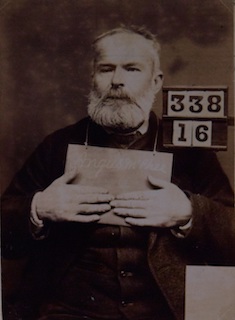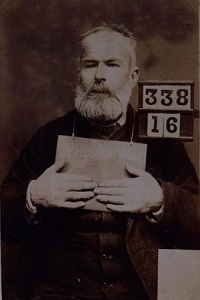
Angus McPhee
Admitted 1857. Murder
Born on Christmas night 1832, Angus was 26 years old when admitted to Perth Criminal Lunatic Department (CLD) after bludgeoning to death his parents and an aunt 'in a maniacal paroxysm' at an isolated community on the island of Benbecula, leaving their bodies 'mangled and bloody'.
Speaking in Gaelic through a translator, Angus' elder brother said he worked as a labourer and had been in good mental and physical health until the spring of 1857, when the family had to shackle him, under the threat of removal to an asylum on the mainland, because of his violent behaviour. 'My father and mother were both averse to part with him and were opposed to his state being reported to the authorities.'
During his first three decades at the CLD Angus was more or less continuously deranged, experiencing sudden episodes of violent insanity. 'Liable to periods of exaltation & destructiveness with recurrent attacks of mania', when 'furiously maniacal' Angus was put in a strait jacket and anklets, when less so in handcuffs. In more placid periods he suffered from persistently held delusions. The prison surgeon noted that he was fixated with his genitals. 'Has an idea that his penis has been injured and is not right and suggested that it might be cut off with a chisel and then it would grow in again straight.' Reported in 1877 to be in love with one of the female attendants, Angus was a chronic masturbator who was given Potassium Bromide, a sedative and anticonvulsant, which also calmed sexual excitement. Its discoverer in the 1850s thought it would help epilepsy, then held to be caused by masturbation and closely linked to insanity.
Psychiatrists or 'alienists' of the mid- and late 19th century were obsessed by such signs of physical and mental degeneracy, which 'must index moral insanity'. Selfish and passionate, the 'habitual criminal' belonged to the 'inferior races of mankind'. With time and treatment, inmates at Perth CLD could begin to experience long periods of sanity, Angus included. In 1897 the prison physician noted he had been 'restless, delusional, and violent' for many years after admission, but had improved during the 1880s and for the last 4 years he had been docile, 'quiet and desponding'. 'With advancing age the maniacal attacks from which he suffered have ceased, so he is no longer a dangerous lunatic.' Psychiatric specialists agreed that conditional discharge into the community remained risky and unconditional release was out of the question, because he was too unpredictable.
Most photographs were taken on admission to Perth CLD, but Angus was done much later - the original prison admission document says he had blue eyes and dark hair. Perhaps it was in January 1900 when, nearly half a century and most of a lifetime after his crime, Angus was transferred to Inverness District Lunatic Asylum, as a pauper patient at the expense of his home parish. He died there the following month, aged 68. His stay at Perth CLD and that of all the other prisoner-patients was paid for by the Scottish Office.
Photograph of Angus McPhee taken from the Criminal Lunatic Department Case Book
Credit: Crown copyright, NRS, HH21/48/1/ page 61
The sketch of the handcuffs used by his family to shackle Angus. This was used as evidence in his trial
Credit: Crown copyright, NRS, AD14/57/176
Post mortem of Mary McPhee, one of Angus’ victims, p1
Credit: Crown copyright, NRS, AD14/57/176
Post mortem of Mary McPhee, one of Angus’ victims, p2
Credit: Crown copyright, NRS, AD14/57/176
Post mortem of Mary McPhee, one of Angus’ victims, p3
Credit: Crown copyright, NRS, AD14/57/176
Report by Dr John McNaughton into the condition of Angus’ mental health. The Dr considers Angus unfit for release, but recommends he be moved to an ordinary asylum. 27th December 1899. Also includes copy report by Dr J. C. Dunlop Acting Medical Advisor and Dr John Fraser, Commissioner in Lunacy, p1
Credit: Crown copyright, NRS, AD14/57/176
Report by Dr John McNaughton into the condition of Angus’ mental health. The Dr considers Angus unfit for release, but recommends he be moved to an ordinary asylum. 27th December 1899. Also includes copy report by Dr J. C. Dunlop Acting Medical Advisor and Dr John Fraser, Commissioner in Lunacy, p2
Credit: Crown copyright, NRS, AD14/57/176
Angus McPhee. Ranald Munro’s statement, 11 July 1857 (NRS, AD14/57/176). Voices: Richard Burns and Mia Colquhoun
Angus McPhee. Medical report by Dr John McNaughton, Perth General Prison, 11 October 1899 (NRS, HH18/96). Mia Colquhoun, Calum Philp, and Craig Smillie














